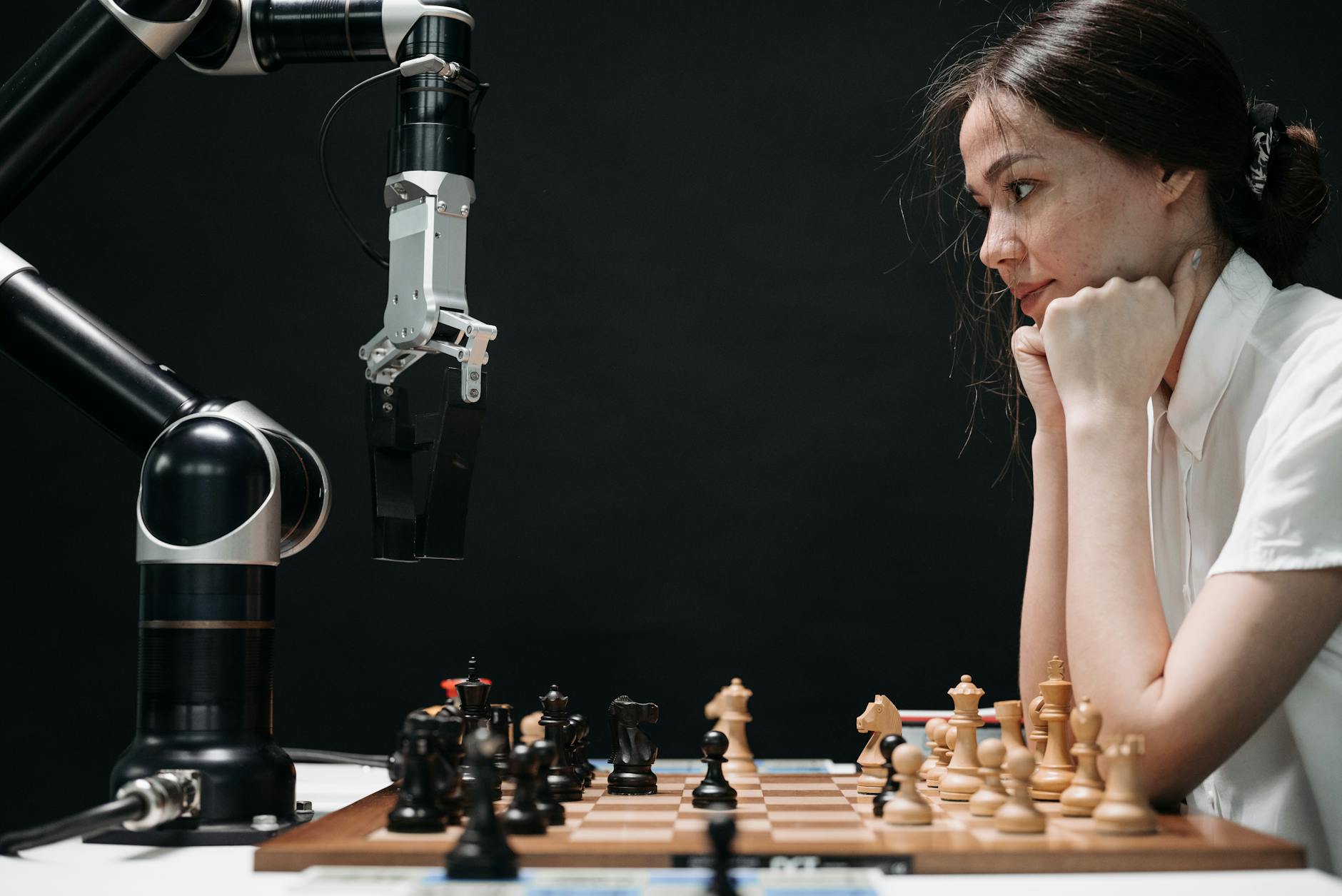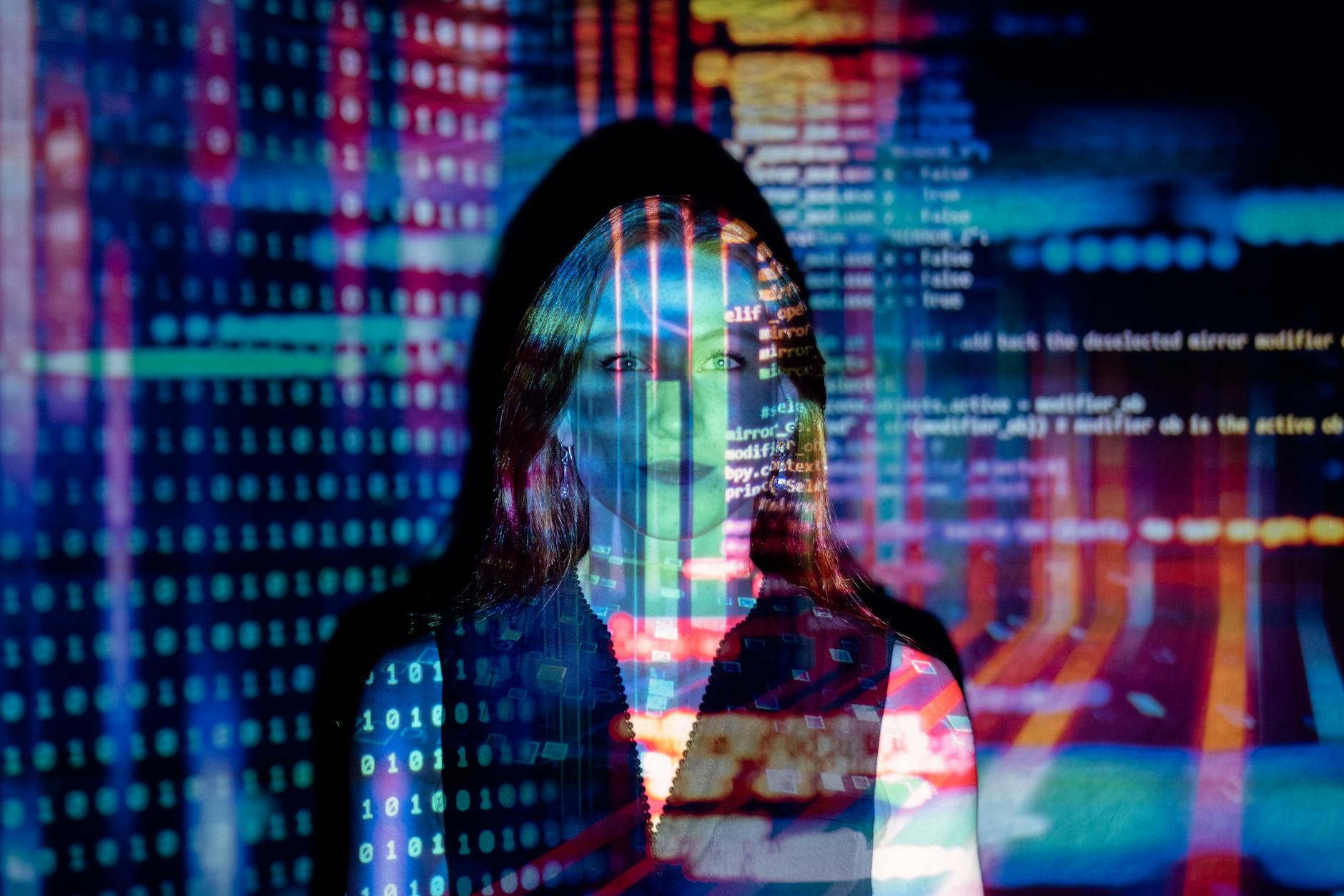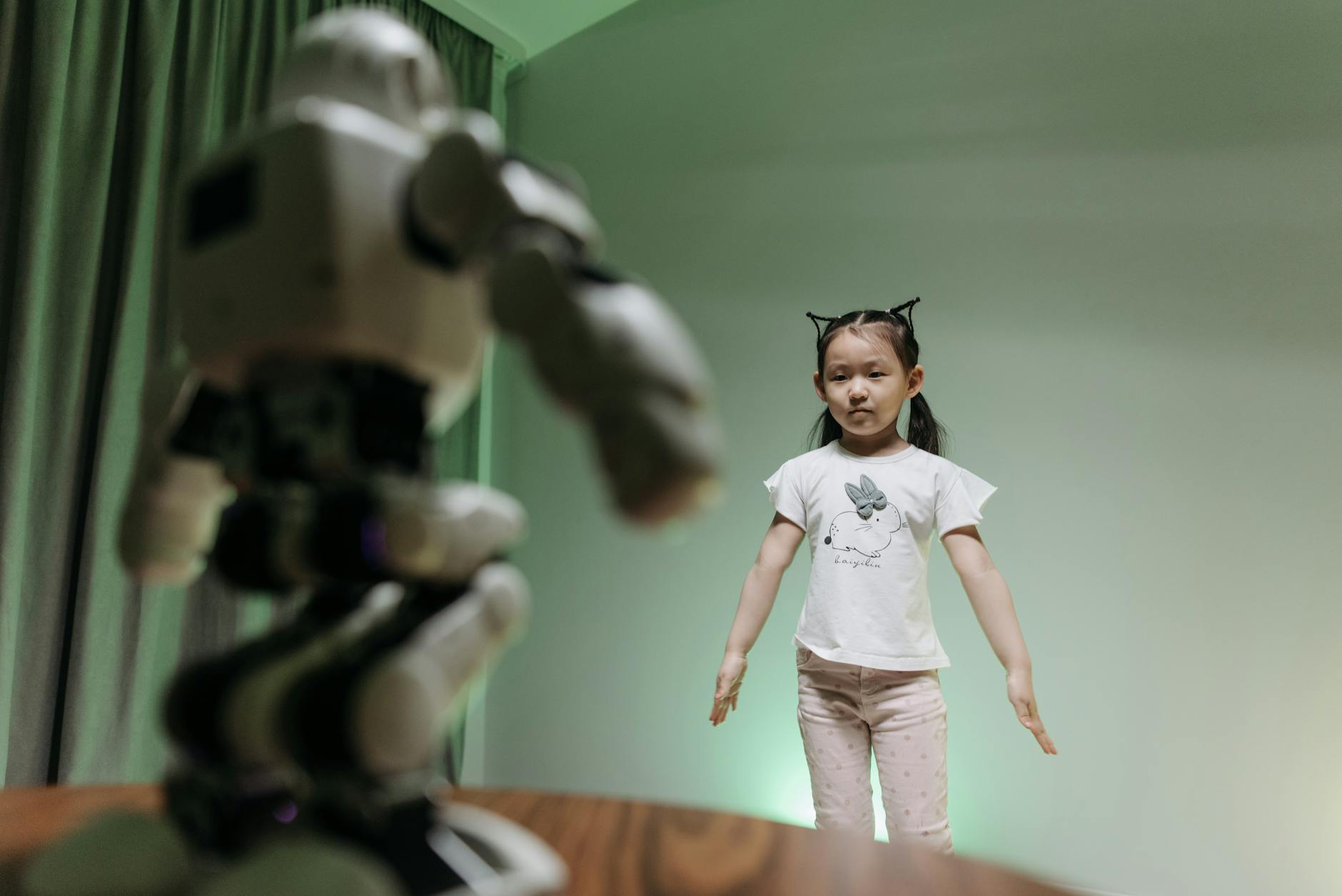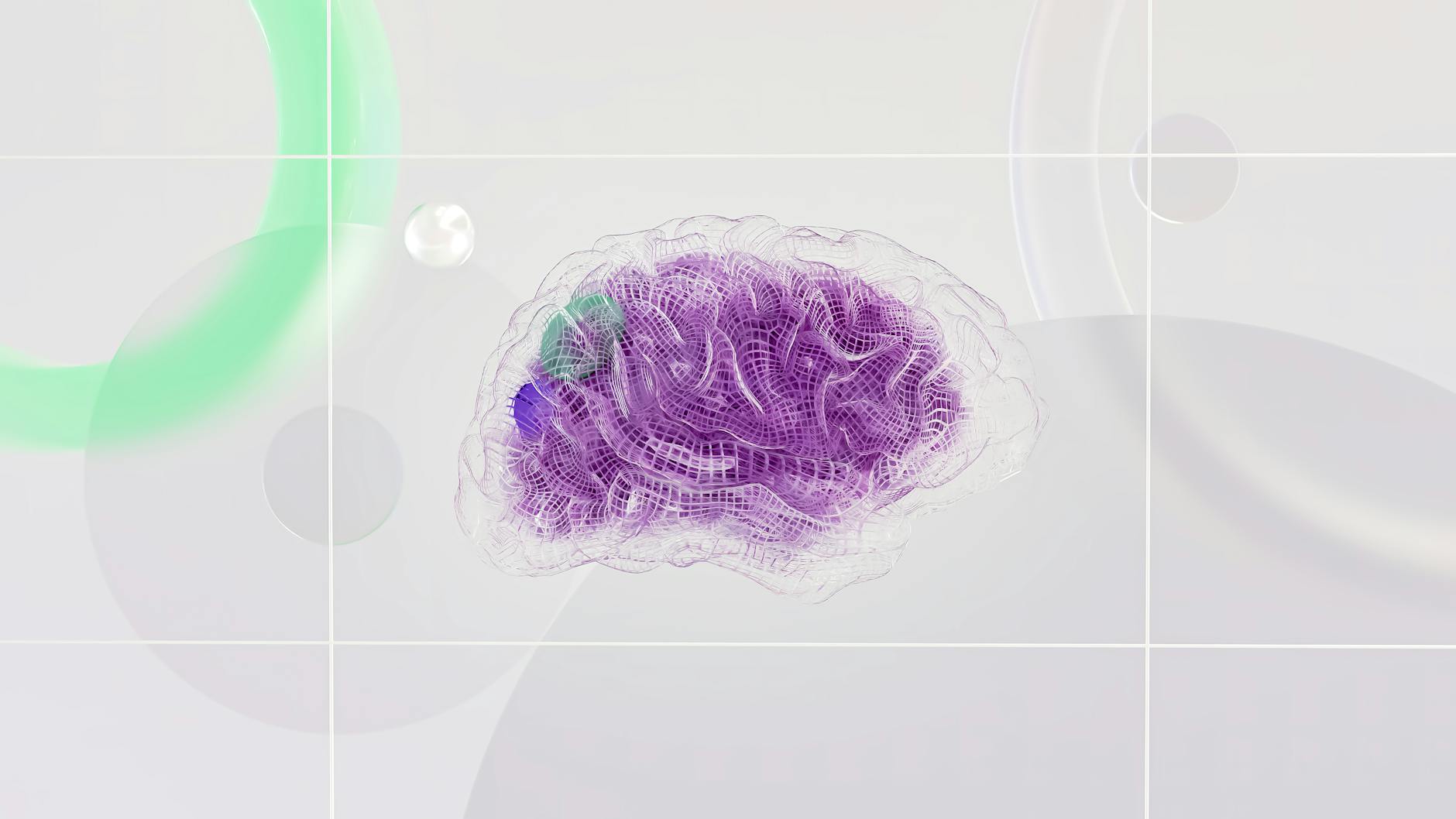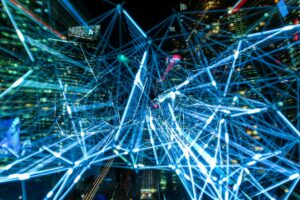A Clash of Titans: AI vs Human Intelligence in the Modern Age
AI vs Human Intelligence
Artificial Intelligence (AI) and Human Intelligence are like chalk and cheese—each has its charm and quirks. Recognizing what sets them apart helps us use them together for the best results.
Understanding AI Capabilities
AI shines at juggling huge piles of data without breaking a sweat. These tech marvels work wonders with algorithms and can make decisions faster than you can say “analytics.” But when it comes to thinking outside the box, feeling emotions, or picking up social vibes, AI hits a roadblock.
| AI Strengths | Limitations |
|---|---|
| Crunching Numbers | Thinking Creatively |
| Heavy Data Lifting | Reading Social Situations |
| Automating Tasks | Understanding Emotions |
AI needs loads of examples to learn stuff. If a human can catch on to something new with just a few tries, AI needs to see a gazillion versions first. Also, when the playbook changes, humans adapt like a chameleon, while AI needs to start from scratch.
| Task | Human Learning Time | AI Learning Time |
|---|---|---|
| Simple Computer Game | 15 mins | 924 hrs |
Human Intelligence in Comparison
Humans bring a mix of sharp thinking and gut instincts to the table. Our ability to learn quickly from just a bit of info and interpret emotions or social clues is a testament to our evolutionary smarts.
| Human Strengths | AI Limitations |
|---|---|
| Gut Feelings | Needs Tons of Data |
| Sensing Emotions | Misses Social Beats |
| Dreaming up Ideas | Limited Imagination |
Our brains let us dive into new games or tasks lickety-split and roll with the punches when rules shift. We’re pros at tasks that need a dash of judgment and a sprinkle of creative flair.
While AI can handle the mundane and crunch numbers at lightning speed, it’s not here to steal our thunder. Instead, it’s like a sidekick helping us tackle the heavy lifting, so we can focus on what we do best: dream, empathize, and create.
By appreciating the perks and quirks of AI and human intelligence, we get the best of both worlds. This synergy boosts our productivity and sparks innovation, blending human ingenuity with AI might.
Impact of AI on Industries
Artificial intelligence is shaking up industries left, right, and center. It’s boosting productivity, sparking fresh ideas, and tossing in a mix of ethical dilemmas. Getting a handle on all these effects shows us what part AI is playing in tech nowadays.
Ethical Concerns and Challenges
AI brings up some major ethical head-scratchers, especially when it comes to privacy, bias, and discrimination. When we let algorithms call the shots, they sometimes carry forward the very biases we’re trying to fight against and can even make them bigger. To dodge these issues, we need a solid mix of human touch and tech smarts.
| Ethical Concern | Description |
|---|---|
| Privacy | These smart systems love scooping up heaps of personal info, causing a stir about privacy. |
| Bias and Discrimination | There’s a risk of algorithms mirroring societal prejudices, leading to unfair decisions. |
| Decision Transparency | If AI’s decision-making process is murky, it can spark trust issues. |
Advancements in Product Development
AI is turning the product development game on its head by cutting back on the endless guesswork. Take pharmaceuticals, for example—where bringing a new pill to market costs about $1 billion (Harvard Gazette). AI jumps in to simulate scenarios, fine-tune compounds, and predict results way better than the old-school ways.
| Industry | AI Contribution |
|---|---|
| Pharmaceuticals | Cuts down time and money by running virtual trials. |
| Manufacturing | Tweaks production lines to slash errors. |
| Automotive | Boosts design and safety using predictive smarts. |
Transforming Operations for Small Businesses
AI gives small businesses a major boost by churning out real-time sales trends, cash flow data, and inventory stats. This knowledge lets them be lean, mean machines without needing more people (Harvard Gazette). By leaning on data, these businesses can sharpen their competitive edge and boost profits.
| Benefit of AI for Small Businesses | Example Application |
|---|---|
| Real-time Insights | Crunching numbers for sales and cash flow |
| Improved Inventory Management | Getting automatic reminders for stock refills |
| Enhanced Customer Service | Using chatbots to handle customer quirks |
With AI in the mix, small businesses can sharpen their operations and concentrate on big-picture growth and keeping customers delighted. By tapping into AI power, they can streamline the daily grind, unravel tricky tasks, and pivot with market twists (Impulse Digital).
AI’s footprint in various fields highlights its knack for sparking innovation and efficiency, all while bringing a pile of ethical puzzles. Wrapping our heads around these hurdles lets us make the most of AI, meshing it with human smarts to create fairer outcomes.
The Debate on AI Regulation
Current Status and Oversight
AI regulation is stirring up quite a conversation. Right now, most companies police themselves when it comes to using artificial intelligence. Governments haven’t really jumped on the bandwagon of keeping a close eye—raising red flags about how ethically these technologies are used. You know, stuff like privacy invasions and bias creep in without strict guardrails.
| Regulatory Aspect | Current Status |
|---|---|
| Government Oversight | Barely There |
| Industry Self-Regulation | Running the Show |
| Privacy Concerns | Sky-High |
| Discriminatory Impact | Huge |
Some heavy hitters like UNESCO are stepping in, suggesting we need some ground rules. They’ve got a Recommendation on the Ethics of Artificial Intelligence that talks about keeping a closer watch, especially where things could get ethically sticky, like in legal courts and artistic expression.
Societal Implications and Bias
We’re facing a bunch of headaches with AI that go beyond just gizmos and gadgets. Stuff like privacy violations, biases—yeah, they’re real. See, these algorithms often spin out whatever biases were in the data they learned from. So instead of fixing biases, AI might just make them worse.
| Ethical Concern | Explanation |
|---|---|
| Privacy Infringements | Snooping around with your data without asking |
| Bias and Discrimination | Algorithms copying human prejudices |
| Human Judgment Role | Tough calls on what’s fair |
A big worry is how AI steps into the courtroom. Sure, machines might speed up verdicts, but can they really be fair? Can they get it right without a human touch? Plus, AI has been showing gender bias too. The developers need to vet their data better to squash those issues.
UNESCO and others are pushing guidelines to tackle these ethical problems so tech doesn’t outsmart morality.
All this chatter around AI regulation highlights the need to balance cool tech with basic ethics. We need solid rules and laws to make sure AI runs smoothly and right.
Cognitive Processes: Humans vs AI
Peeking into the way AI and humans process stuff upstairs gives us a mixed bag of sweet skills and a few hiccups. Two biggies: how they learn and adapt, and their flair for emotions and creativity.
Learning and Adaptability
Learning’s like the bread and butter of understanding what AI and humans can do. When it comes to crunching tons of numbers and tackling giant calculations, AI’s got it made in the shade. Picture this: a human might need five minutes to untangle one math problem, but AI whizzes through ten in a snap. Speedy, huh?
Now, when we think of humans, they learn by soaking up all kinds of stuff—life’s their classroom. This mix-and-match learning style lets them solve problems like they’re cracking puzzles and dream up new ideas on the fly. AI, by contrast, learns like a bookworm—only what’s fed to it through data and practice, minus the daydreaming.
| Attribute | AI | Human |
|---|---|---|
| Learning Method | Data it digs and practices again and again | Life’s diverse lessons, big and small |
| Processing Speed | Off the charts (multi-tasking master) | Takes a breather (one thing at a time) |
| Ability to Think Abstractly | Nope | You betcha |
| Adaptability | Just hangs with what’s been told | Goes with the flow |
Emotional and Creative Aspects
When we enter the feels-and-arts zone, AI kind of trips over its feet compared to humans. Sure, it can handle tasks like nobody’s business and spit out answers in a flash, but when it comes to vibes and feelings, it’s a no-show.
Human creativity springs from life’s ups and downs, gut feelings, and that “spark” that makes art and empathy possible. Stepping into AI’s world, it runs on step-by-step instructions without catching a wink of what a real tear or smile is. This makes AI fall short in zones where heart really matters.
| Attribute | AI | Human |
|---|---|---|
| Emotional Intelligence | Kind of clueless | Tuned-in (feels the feels) |
| Creativity | Paints-by-numbers style | Imagination unleashed |
| Social Interactions | Doesn’t do chit-chat | Like a social butterfly |
At the end of the day, AI might breeze through data like nothing, yet it bumps into walls when emotions and creativity come knocking. Humans, in all their flexible, imaginative, and emotional glory, take the trophy when it’s a question of heart and soul.
Multimodal Learning and Human Adaptability
Multisensory Input Integration
Humans are pretty amazing when it comes to taking in information from all directions—literally. They can listen, see, touch, and even smell their surroundings, which helps them make savvy decisions on the fly. Just think about chilling with a good book: you’re hearing some tunes, feeling the paper, and maybe catching a whiff of that old-library smell. Each of these senses comes together to paint a richer picture.
Now, you might think AI would be up to this kind of thing by now. It’s 2023 and some AI, like those fancy self-driving cars, do mix and match inputs from cameras and radars. But turning that mash-up of data into something resembling human thought? We’re not quite there yet (TechTarget). AI systems rock at processing tons of data super fast, but they’re running on cold, hard logic, not the kind of subjective experience humans get from their senses.
Comparison of Sensory Integration
| Aspect | Human Intelligence | AI Systems |
|---|---|---|
| Sensory Integration | Multisensory (sight, sound, touch) | Single/multi-sensor processing |
| Decision Making | Subjective, experience-based | Algorithm-driven |
Learning from Senses and Experience
Humans don’t just learn from textbooks—they’re soaking it all in from life’s experiences, emotions, and the occasional mistake. This kind of learning isn’t just black or white but full of shades, helping folks apply what they pick up in all sorts of situations. Whether someone’s honing a craft or telling a story, their past influences what they do.
AI, in contrast, learns by getting fed mountains of data and doing the same thing over and over—sorta like practice makes perfect. It’s good at crunching numbers and spitting out answers but misses out on daydreaming and feeling emotions. AI sticks to its syllabus; give it something off-script and it might just scratch its virtual head.
| Learning Element | Human Intelligence | AI Systems |
|---|---|---|
| Learning Mechanism | Experience and abstraction | Data exposure and algorithms |
| Adaptability | High, context-sensitive | Limited, context-specific |
| Cognitive Processes | Imagination and reasoning | Data-driven logic |
Humans are still the gold standard when it comes to using all their senses and soaking up life’s lessons. AI continues to inch forward but remains boxed in by its code and data. Knowing what each can and can’t do gives us a clear view of where to rely on human smarts or let AI take the wheel.
Gender Bias and Ethical Considerations
Addressing Gender Bias in Algorithms
Dealing with gender bias in AI is a big deal nowadays. It’s like when tech takes a side in the gender debate without even knowing it, thanks to skewed info or flawed algorithms. The UNESCO Recommendation on the Ethics of Artificial Intelligence stresses cutting down or nixing this bias early on, from designing the algorithms to deploying them (UNESCO).
With worries growing, companies and researchers are hustling to fix these biases. A smart move is making sure data sets for AI training are super diverse. Plus, developers are upping their game with solid testing methods to sniff out and mend biases. Such steps are crucial for fostering fairness and making sure AI decisions are inclusive.
AI in Judicial Systems and Cultural Creativity
As AI steps into courtrooms worldwide, it’s stirring up talk about fairness in justice. AI tools could streamline case reviews and justice delivery way faster than what judges can usually handle. They help judges draft new decisions, making verdicts consistent and quicker. But as we count on machines to parse through justice, there’s a need for solid ethical guidelines to keep it just and open (UNESCO).
AI in Judicial Systems Table
| AI Role in Judiciary | Description |
|---|---|
| Case Evaluation | AI looks at legal cases, proposing rulings. |
| Decision Support | Assists judges in crafting new decisions and analysis. |
| Automatization of Justice | Optimizes efficiency in justice handling. |
Then there’s AI shaking up the art scene. Take the time a computer and 3D printer knocked out a painting looking an awful lot like a Rembrandt or when an AI finished the last parts of Franz Schubert’s Symphony No.8. Who owns the creative rights, and should AI get a tip in the hat for this? All these raise eyebrows about AI’s impact on creativity and the value chain involved.
By tackling these ethical puzzles, we can better mold AI to fit responsibly and fairly within society and our systems.
AI Development and Human Integration
Hybrid Approach to AI Development
Growing AI to think a bit like us involves blending two ways of being smart–one old school, one new. The cool stuff of today—deep learning—is ace at spotting patterns but pretty clueless when explaining itself. On the other hand, those classic machine learning tricks are slow and not great with big data but they’re like an open book when it comes to understanding their choices. When you throw these together, bingo! You’ve got an AI that’s not only sharp but also talks sense, just like you and me.
| AI Development Approach | Capabilities | Limitations |
|---|---|---|
| Deep Learning | Spotting patterns like nobody’s business, handling a ton of data | Doesn’t really justify decisions, acts like a black box |
| Traditional Machine Learning | Explains itself clearly, reasons well | Sluggish with data and can’t handle big datasets |
By cherry-picking the best bits from both worlds, AI wizards can whip up smarter, clearer systems that think things through. This mash-up doesn’t just stay book-smart; it could wise up enough to roll into any industry, from curing people to managing money.
Future Outlook: AI Collaboration with Humans
Moving forward, AI’s going to be everywhere in our work lives, teaming up with folks as cobots—robots willing to lend a hoof! These will be the software inside machines, making them gel with us humans and help out with jobs. The best part? These cobots learn fast and don’t need endless refreshers, evolving to back us up instead of dodging us out.
| Aspect | Current State | Future Outlook |
|---|---|---|
| Workplace Integration | Used for niche jobs | All over the place and easily adjusting |
| Human-AI Interaction | Barely hanging out | Easy-going and feels like second nature |
| Task Performance | Does the same ol’ | Quick to adapt and handles different tasks |
AI’s future vibe is one of sidekicks, boosting human skills instead of elbowing us out of the way. AI will get the grunt work done—the kind that’s all data—letting us handle the quirky, creative stuff it can’t touch. This tag team will crank up productivity in every field, building a solid partnership between our smarts and machine savvy.
The Evolution of AI and Human Interaction
AI and humans have gotten pretty cozy over time, shaking up offices and supercharging our skills. Here, we’ll take a gander at how cobots are changing the game at work and how AI’s there to back up and boost what humans can do.
Workplace Transformation and Cobots
Lately, AI’s gotten comfy at the office in the form of cobots, or collaborative robots, working hand-in-hand with humans (Forbes). These not-so-clunky bots get along with folks at work, lending a hand with a bunch of tasks and helping things run slicker.
What sets Cobots Apart:
| Feature | Cobots | Traditional Robots |
|---|---|---|
| Interaction with Humans | Team player and friendly | Works solo |
| Task Flexibility | Tops | Just okay |
| How Users Feel | Easy-peasy | Bit of a puzzle |
| Safety | Safe-bet features | Needs guards |
Cobots tackle the tedious, number-crunching work, freeing humans to do what they do best—being creative, solving tricky problems, and thinking outside the box (Simplilearn). Looking ahead, AI is expected to become as common as office plants, boosting productivity and setting the stage for a mix of brains and bytes working together seamlessly.
AI Supporting Human Capabilities
AI’s got our backs, tidying up our daily grind and handling the messy stuff (Impulse Digital). You’ll spot its influence everywhere from ads to classrooms to the boardrooms, and even playtime entertainment.
Big Wins for AI in Helping Us Out:
- Always On: AI tools never sleep, meaning round-the-clock access for learning or productivity spurts (Impulse Digital).
- Get Rid of the Drudgery: AI’s an ace at automating the boring bits, letting us humans tackle the brainy challenges (Simplilearn).
- Fast and Precise: Breaking down complex stuff into bite-size pieces for quick, sharp execution.
Sure, AI’s great at following directions, but it’s our human smarts that bring unique ideas and those touches of emotional brilliance to the table (Impulse Digital). This teamwork between AI and us means more bang for our buck in terms of innovation and getting stuff done for folks and companies alike.
As AI and people continue to buddy up, we’re looking at a future where cobots and smart systems are indispensable in backing up and bolstering what we can do, crafting a workspace that’s not just efficient but also in tune with what makes humans tick.
